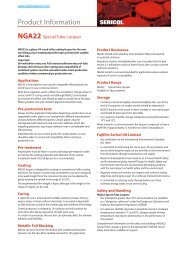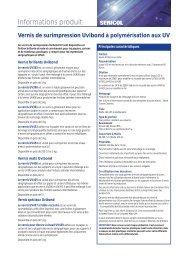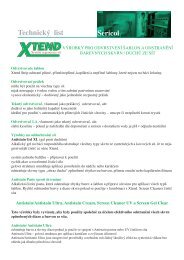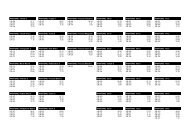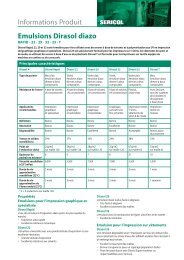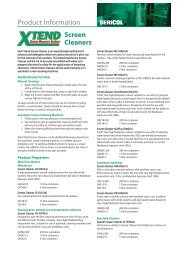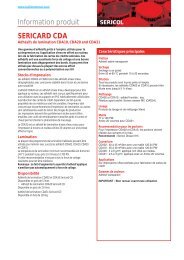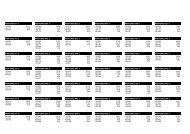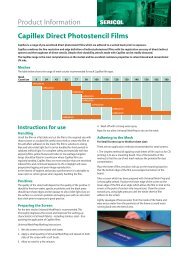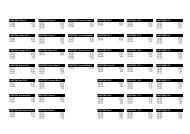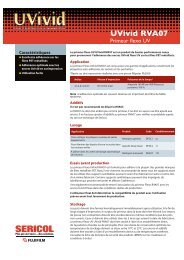Autotype Indirect Photostencil Films - FUJIFILM SERICOL
Autotype Indirect Photostencil Films - FUJIFILM SERICOL
Autotype Indirect Photostencil Films - FUJIFILM SERICOL
- No tags were found...
You also want an ePaper? Increase the reach of your titles
YUMPU automatically turns print PDFs into web optimized ePapers that Google loves.
<strong>SERICOL</strong><strong>Autotype</strong> <strong>Indirect</strong> <strong>Photostencil</strong> <strong>Films</strong>FIVE STAR • GREENSTAR • ALPHA STAR • NOVAPLUS<strong>Indirect</strong> <strong>Photostencil</strong> <strong>Films</strong> are perfect for short to medium runhigh quality work, where their quick processing times enable fastproduction. They are resistant to solvent based and conventionalUV curing inks. <strong>Indirect</strong> films are processed separately from thescreen and are suitable for a wide range of mesh counts.PropertiesFive StarRed pre-sensitised gelatine coating on a 50 micron polyester base.Medium/high resolution, exceptional print quality and wideprocessing latitude make Five Star perfect for most general purposeapplications.GreenstarGreen pre-sensitised gelatine coating on a 50 micron polyester base.Low resolution and high definition make Greenstar perfect formultilayer or composite positives where the tape edges can be burntout.Alpha StarBlue pre-sensitised gelatine coating on a 50 micron polyester base.Ultra high resolution and print quality make Alpha Star perfect forvery fine line or halftone work.NovaplusUnique, red, pre-sensitised coating on 70 micron polyester baserequiring no chemical hardening. Quick and simple chemical freeprocessing with cold or warm water washout.Instructions for UseHandlingUnroll film on a flat surface and cut to the required size taking carenot to kink or crease it. The films are sensitive to strong blue andartificial light but can be handled for short periods in subdued light.For complete safety, yellow fluorescent tubes should be fitted in theworkroom.Always return unused film to the container and replace capimmediately after use as the sensitivity of the product can be affectedby excessive exposure to humid conditions.PositivesThe quality of the stencil will depend on the positive. It should be freefrom stains, specks or pinholes and the image areas should have sharpedges and be opaque to ultra-violet light. Dust on the surface is acommon problem: wiping with an anti-static cloth prior to exposure isgood practice.ExposingLay the positive on the glass of a vacuum exposure frame, with thecorrect reading image uppermost. Place the photostencil film withuncoated side in contact with the positive.The following table is intended as a guide only because light sourcesvary according to their age and manufacture.Exposure Guide (in seconds, at 120 cm lamp distance)Five Star Greenstar Alpha StarNovaplus1000W Metal Halide 360 480 440 1802000W Metal Halide 300 400 360 1253000W Metal Halide 240 300 270 755000W Metal Halide 180 240 220 606000W Metal Halide 150 200 180<strong>Autotype</strong> Exposure CalculatorThis invaluable aid has been designed to accurately determine theoptimum exposure time for any photostencil material. Its use isrecommended particularly with a new stencil material, a new lightsource or whenever the unsatisfactory performance of a stencilmaterial could be caused by incorrect exposure.HardeningAll indirect films (except Novaplus which requires no hardening):Prepare a solution of <strong>Autotype</strong> Powder Activator according to theinstructions on the pack. Using Powder Activator produces extremelyrobust stencils which will withstand vigorous spraying during warmwater development. Immerse the film, immediately after exposure, in adish of the solution for one minute at room temperature. Anydiscolouration of the hardening solution at this stage is due to theremoval of the top protective layer of the emulsion coating and doesnot impair the performance of the film or hardening solution. Thehardener solution can be used for a few days but it rapidlydecomposes when exposed to light. The dish should therefore becovered when not in use.DevelopingGently spray the film with warm/hot water (or cold water forNovaplus) until the image areas are completely clear. Do not exceed45°C and avoid over washing as adhesion may be impaired. Chill withcool water for 10-15 seconds before applying to the screen.Preparing the ScreenDegrease and pre-treat new screens with Xtend Prep 101 (seeinformation sheet ‘Mesh Preparation and Degreasing Chemicals’),followed by Universal MeshPrep or Autobond X Mesh Conditioner.Universal MeshPrep thoroughly degreases the screen and improvesthe wetting-up characteristics of all mesh fabrics - including stainlesssteel - assisting the application of photostencil films.Universal MeshPrep working instructions:1 Wet the screen with water.2. Apply a small quantity of Universal MeshPrep and spread on bothsides of the screen with a soft brush.3. Allow to react for a few minutes and wash off with a strong waterspray.Do not allow Universal MeshPrep to dry in the mesh.Autobond X is a simple method of providing outstanding adhesion of<strong>Autotype</strong> and most other photostencil films to polyester or nylonscreen fabrics. The adhesion obtained is through true chemicalbonding. Newly stretched mesh should be slightly abraded withPrep 101.Autobond X working instructions:The screen must be dry before application .1. Saturate a clean piece of cotton wool or cloth pad withAutobond X.2. Wipe evenly over the whole of the print side of the screen,applying a liberal coating.N.B. Excessive over exposure may result in poor adhesion to the meshand under exposure may produce weak stencils.
<strong>Autotype</strong> <strong>Indirect</strong> <strong>Photostencil</strong> <strong>Films</strong>3. When the whole screen has been well wetted the solvent shouldbe evaporated, preferably with warm air. It is likely that traces ofAutobond X will appear to fill the mesh of fine fabrics. This isharmless as the excess material will readily wash away beforemounting the film.Do not touch or rub the screen prior to applying the photostencilfilm, which should be within 24 hours of treating withAutobond X.Stencils can be applied to recycled screens after repeating theAutobond X treatment.AdheringPosition the film face downwards onto the print side of the mesh andthen invert the screen onto a raised pad and lightly weight to pressthe fabric into contact with the film. Absorb excess moisture throughthe fabric by placing newsprint on it and roll firmly with a roller.Repeat until all excess moisture is removed, this is particularlyimportant with fine detail images. Any remaining gelatine containingmoisture will tend to drain into the washed out areas and on dryingwill form a veil across the open areas which is impossible to removewithout ruining the stencil.To obtain good adhesion to the mesh thefilm should have a thin soft layer of gelatine on the surface. This willproduce a deposit of colour on the absorbant paper when pressedinto the mesh.DryingAlthough indirect film dries very quickly, drying can be acceleratedwith a fan at ambient or moderate temperature. When dry, carefullypeel away the backing film. The space between the edge or the stenciland frame should then be blocked out with ‘<strong>Autotype</strong> Screen Filler’.Reclaiming the ScreenGelatine Stencil Remover working instructions (for Novaplus useXtend strip):1. Remove all traces of ink with a rag soaked in an Xtend ScreenCleaner.2. Wash away any water soluble fillers with cold water.3. Apply Gelatine Stencil Remover with a brush or sponge to bothsides of the screen.4. Allow to react for a few minutes, then rub the back of the screenand the stencil will break up.5. Wash off residue with warm water or, preferably, with a highpressure water gun.See product information sheets ‘Xtend Screen Cleaners’ and ‘StencilDecoating and Mesh Stain Removal Products’ for working instructions.Standard PackingFive Star <strong>Photostencil</strong> FilmFSA02 Rolls 1.04 x 5mFSA01 Rolls 1.04 x 10mFSE88 Rolls 1.22 x 10mGreenstar <strong>Photostencil</strong> Film:GNN74 Rolls 1.04 x 10mGNN76 Rolls 1.22 x 10mAlpha Star <strong>Photostencil</strong> Film:ATK99 Rolls 1.04 x 10mATJ48 Rolls 1.12 x 10mNovaplus <strong>Photostencil</strong> Film:NSP01 Rolls 1.04 x 10m<strong>Autotype</strong> Powder Activator:AAA10 100g containers, to make up to 2 ltrs of hardening solution.AAN47 750g containers, to make up to 15 ltrs of hardening solution.Universal MeshPrep Degreasing and Wetting Fluid:ABU70 5 ltr container.Autobond X Mesh Conditioner:ABC60 1 ltr containers.Storage<strong>Indirect</strong> <strong>Photostencil</strong> <strong>Films</strong>:Store in a cool place, preferably in the protective tubes supplied. Keepaway from photographic papers, films, cardboard or plywood, whichmight contain synthetic glues or preservatives such as formalin. Donot store in a damp place.<strong>Autotype</strong> Powder Activator:Store in original container, away from direct sunlight or any sources ofheat and combustible materials.Universal MeshPrep Degreasing and Wetting Fluid:Store in original container in cool, dry environment.Autobond X Mesh Conditioner:Store away from heat. Always tightly close container after use.Safety and Handling<strong>Indirect</strong> <strong>Photostencil</strong> <strong>Films</strong> and Universal MeshPrep:These materials are not hazardous when used with reasonablestandards of industrial hygiene and safe working practice.<strong>Autotype</strong> Powder Activator:Contains Hydrogen Peroxide. It is irritating to the skin. After contactwith skin, wash immediately with plenty of water.Autobond X Mesh Conditioner:Contains Trichloroethane. It is harmful by inhalation and should beused in well ventilated conditions. Avoid contact with skin and eyes.Environmental Information<strong>Indirect</strong> <strong>Photostencil</strong> <strong>Films</strong>:These products are water dispersible coatings on polyester film.Polyester is recyclable as clean scrap polyester film when separatedfrom the coating. A local processor should be contacted. The coatingsdo not contain any materials regarded as ecotoxic or which are ECblack or grey listed. Tests have shown no inhibition of activated sludgeof typical effluent concentrations and the workings from the coatingmay be regarded as drain safe and biodegradable.<strong>Autotype</strong> Powder Activator:In concentrated form the product can show biocidal activity but intypical effluent concentrates tests have shown no inhibition ofactivated sludge and workings may be regarded as drain safe andbiodegradable.Universal MeshPrep Degreasing and Wetting Fluid:In normal use typical effluent concentrations should not inhibitactivated sludge and the product may be regarded safe andbiodegradable.Autobond X Mesh Conditioner:Dispose of only as chemical or solvent waste. Do not contaminatedrainage system. After mesh application the solid material adheres tothe mesh and effluent content is minimal.
<strong>Autotype</strong> <strong>Indirect</strong> <strong>Photostencil</strong> <strong>Films</strong>Problems and SolutionsFaultsProbable Cause and Remedies1. Patchy stencil a. Uneven washout - evenly wash both image and non-image areas of the exposed stencil film. Avoidexcessive washout temperature and pressure.b. Poor quality positive - avoid montages or excessive use of adhesive tape.2. Scumming a. Inadequate washout of film - wash out at recommended temperature with a strong water spray.When image areas appear clean, continue washing for a further 30-60 seconds.b. Washed out film left to drain - mount film immediately after washout.c. Film fogged before or after exposure - keep film sealed when not in use. Avoid direct sunlight at all costs.3. Emulsion washes a. Under exposure - increase exposure time.away during washout b. Film exposed on the wrong side, i.e. emulsion side - expose film through the base (glossy side).c. Light source low in UV emittance - replace bulb or use alternative actinic light source.d. Film has dried out - discard and use another piece of film.e. Excessive washout temperature or pressure - use recommended washout temperature.Use firm but not excessive water pressure.4. Pinholing a. Dust or marks on glass of exposure frame, film positive or base of indirect stencil film - clean glass ofexposure frame regularly. Check positives for marks or dust. Remove any dust with an anti-static clothb. Under exposure (stencil is weak in appearance. A common problem with montages and taped up positives) -increase exposure time.c. Use of rough vacuum blanket during exposure - protect film from blanket with plastic or cardboard sheet.5. Premature stencil a. Ink contains aggressive solvents, abrasive particles (e.g. solder cream, glitter ink), waterbreakdowncontamination or rough printing stock (e.g. PCB tracks) — use more robust stencil system (e.g. Capillex).b. Washups too frequent or incorrect technique - minimise washups by using correct balance of retarderand thinner in ink to prevent drying in.6. Poor resolution a. Wrong film selected for high resolution printing - use a high resolving film such as Alpha Star or Five Star.b. Positive of poor quality, or detail too fine - check quality. Is density even? Details as fine as 50-60 micronscannot always be printed, depending on the resolution of the film used.c. Over exposure - reduce exposure time. See a. above; do NOT under expose a medium resolution film toprint high resolution work: a weak stencil will result.d. Mesh fabric too coarse for desired print resolution - use finer mesh count.e. Excessive pressure used during mounting of film - use firm but not excessive pressure.f. Poor light source geometry - avoid multiple light sources, banks of fluorescent tubes etc. Use a pointlight source at a minimum distance of 1.5 times the diagonal dimension of the vacuum frame.g. Poor contact during exposure - use a good quality vacuum frame.7. Poor edge definition a. Positive has poor edge quality - check positive with a magnifier.b. Mesh fabric too coarse to obtain desired print quality - use finer mesh count.c. Uneven mounting surface with high spots - mount stencil onto mesh using a flat built up board (glassor Perspex) for support.d. Excessive pressure used during mounting of stencil film - use firm but not excessive pressure.8. Poor adhesion a. Inadequate mesh pre-treatment, abrading and degreasing - new synthetic mesh requires abrading beforeuse and recycled screens must be degreased, see section ‘Preparing the Screen’.b. Inadequate mounting pressure - mount stencil film onto mesh using firm pressure.c. Mesh count too coarse to hold fine detail images - use finer mesh count.d. Excessive washout temperature or time - reduce washout temperature/time.9. Brittle stencil Stencil over exposed - reduce exposure time.
The information and recommendations contained in this Product Information sheet, as well as technical advice otherwise given by representatives of our Company, whether verbally or in writing, arebased on our present knowledge and believed to be accurate. However, no guarantee regarding their accuracy is given as we cannot cover or anticipate every possible application of our products andbecause manufacturing methods, printing stocks and other materials vary. For the same reason our products are sold without warranty and on condition that users shall make their own tests to satisfythemselves that they will meet fully their particular requirements. Our policy of continuous product improvement might make some of the information contained in this Product Information sheet outof date and users are requested to ensure that they follow current recommendations.<strong>FUJIFILM</strong> <strong>SERICOL</strong> UK LIMITEDPysons Road Broadstairs Kent CT10 2LE United KingdomTel: (01843) 866668 Fax: (01843) 872184UK Sales Tel: (01992) 782619 Fax: (01992) 782602Email: uksales@fujifilmsericol.comCustomer Service Centres Tel: 0845 084 89 89Export SalesPysons Road Broadstairs Kent CT10 2LE United KingdomTel: +44 (0)1843 866668 Fax: +44 (0)1843 872122Email: exportsales@fujifilmsericol.comwww.fujifilmsericol.com PRINTED IN ENGLAND 0737/O8



